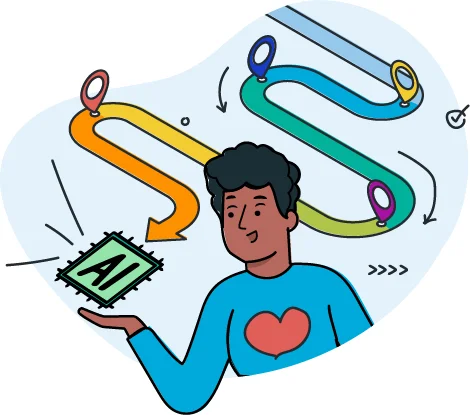
Related Services
Change managementTechnology enablementSee more in our AI series
AI, everywhere, all at once: Leading with empathy through AI automation
The artificial intelligence (AI) revolution is here to stay—42% of companies are exploring AI adoption and many have already started implementing it. Organizations will want to rush to be the first to implement AI, but they must focus on doing it effectively and sustainably. As AI rapidly advances, imagine if large language models—AI tools that use vast amounts of data to generate new content—continue to progress at a rate comparable to iPhones. An organization could end up purchasing or adopting a new version every year, compounding costs and causing frivolous disruption not anchored in a clear understanding of what that investment is contributing to the organization.
More than 8,000 AI tools have been introduced in the last eight years, with an average annual growth rate of more than 3X since 2015, and an 11X increase in this year alone. Charged with technology-driven delivery and touting a “fail fast” iterative mindset, an overly eager IT professional may suggest the application of an “Agile Methodology,” with their adoption of AI, when there are more thoughtful ways to implement it successfully.

AI tools have an average annual growth rate of 3X since 2015, and an 11X increase this year alone.
Leaders should focus on a design thinking approach to embrace AI transformation incrementally and organically, building upon a strong and appropriately contextualized foundation for future resilience.
The Navy SEALs have a valuable motto: “Slow is smooth, smooth is fast.” This principle underscores the importance of precision in achieving objectives and can be applied to the planning process for technology-driven operational changes. More than 20 years of experience partnering with organizations to drive enterprise-wide, transformative change indicate that leaders should adopt AI incrementally rather than attempting a wholesale transformation. By taking measured, incremental steps, organizations can achieve their goals more effectively and efficiently, while ensuring that employees are given the proper resources to successfully integrate AI adoption into their roles.
Short-term decisions, long-term consequences
There’s no question that AI can be a gamechanger for organizations by streamlining processes and highlighting insights and patterns that are difficult for humans to see. But many are getting swept up in the shiny object appeal of this new technology, which can often result in the adoption of AI tools too quickly.
Constant updates and abrupt implementation without aligning to ROI and efficiency can lead to wasted investments and operational inefficiencies. If AI isn’t properly introduced or deployed in the right areas, organizations risk low adoption, missed opportunities, and lackluster returns on their technology investments.

Speeding to full-scale adoption of AI can also present risks in safeguarding human-centered control over processes controls, without which organizations are more prone to face worrisome mishaps that can mar a brand reputation and employee morale in the long term.
Consider the recent example of Dukaan CEO Suumit Shah firing 90% of his support staff in favor of a chatbot, and broadcasting the news on X that the average time taken to resolve a customer’s issue dropped by almost 98%. While he described the decision as purely financial, Shah faced swift backlash after countless users tweeted that his support team losing their income stream was nothing to celebrate. Or consider Vanderbilt University using ChatGPT to pen a statement on the Michigan State University shooting. The letter mentioned creating a culture of respect and understanding on campus, and ended with a sentence in parentheses that read, “Paraphrase from OpenAI’s ChatGPT AI language model, personal communication, February 15, 2023.” Critics countered that a statement on such a sensitive topic should be grounded in human empathy and respect.
The lesson from these stories is that short-term decisions can have long-lasting, unintended consequences. While AI adoption and large language models have the potential to drive significant efficiencies, realizing their full ROI requires a human-centered approach. Thoughtful adoption, prioritizing user experience, training, and real-world workflows, ensures AI enhances productivity rather than creating friction, ultimately leading to sustained efficiency gains.
Organic adoption of AI beats an AI overhaul
Instead of rushing to implement AI, think about where your employees are feeling the most pain, and involve them in implementation. Only 19% of workers say their company invests in the right technology to support them, according to Eagle Hill polling. As a result, 83% of employees perceived that technology is not improving their ability to add value to the organization. This polling shows that it’s more important to be the organization that gets AI adoption right, rather than be the first.

Need a roadmap on how to start AI implementation?
How to boost technology adoption: The secret to boosting ROI with the human factor
Quickly implementing AI can lead to wasting resources on tools that don’t help your workforce accomplish organizational goals. Organic integration, on the other hand, can boost performance by incorporating AI tools that improve productivity without harming your organization’s reputation or morale. And when AI is integrated humanely, positive employee experience is preserved.
Starting small might look like introducing training to use out-of-the-box large language models (LLMs), such as ChatGPT, as a desktop job aid. Or implementing robotic process automation (RPA) to regulate data quality and manual work activities before embracing large-scale AI adoption. RPA is an automation technology that can take the work people generally dislike off their plates, for instance, logging into applications and scraping data from the web. RPA makes people more productive by taking care of mundane work, while still leaving important decision-making processes that require human empathy to the individual.
By automating discrete pieces of the process and monitoring the results, leaders can have a clearer picture of where AI works well and improves decision making.
AI Adoption Challenges and Benefits
The adoption of AI can transform how organizations work—boosting efficiency, improving decision-making, and freeing employees to focus on higher-value tasks. However, the journey to adopt AI comes with challenges.
Success depends on having the right data, yet many organizations struggle with data management and quality issues. AI systems are only as good as the information they’re given, so organizations must ensure they have high-quality, well-structured data to feed these complex systems. Integrating AI with existing technology is another hurdle that requires careful consideration. Many organizations rely on legacy systems that weren’t built to support AI, requiring substantial upgrades and training for employees.
To navigate these AI adoption challenges, leaders need a clear strategy that goes beyond just talent. Successful adoption requires aligning people, technology, change management, and processes to ensure AI delivers real value. That means not only investing in digital upskilling and hiring new talent where needed but also improving how data is organized and used. It also means making sure AI works smoothly with existing systems and streamlining processes to boost efficiency. And to ensure AI is used responsibly, organizations need clear guidelines, strong oversight, and a plan to manage change. By taking a holistic approach, AI doesn’t just get implemented—it transforms how work gets done.
Staying thoughtful
AI adoption is upon us; it’s important that we integrate it into our organizations thoughtfully and prioritize people along the way. The litany of AI mishaps in the news are no coincidence. As AI adoption ramps up, countless companies will rush to adopt it without stopping to think about long-term effects. The most successful organizations will focus on integrating AI in a way that enhances productivity, aligns with existing workflows, and empowers employees—ensuring both the technology and the people using it drive meaningful results.
Let’s get started
Learn how Eagle Hill’s holistic approach to integrating automation into your operations can help you unlock efficiencies and get the best results from your technology investments.


